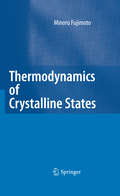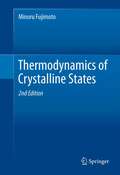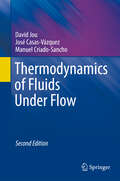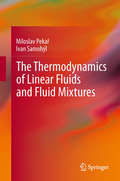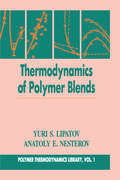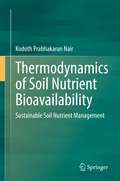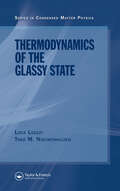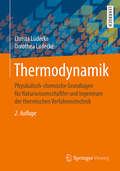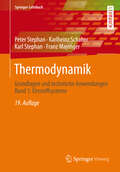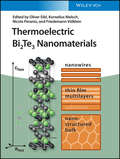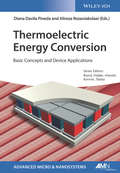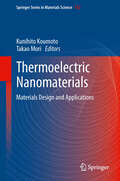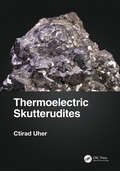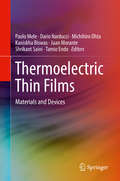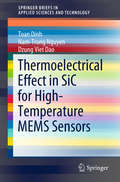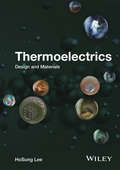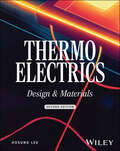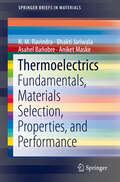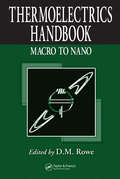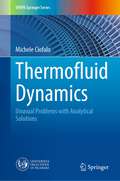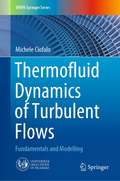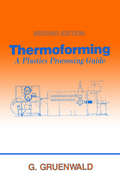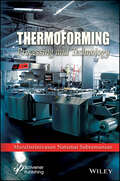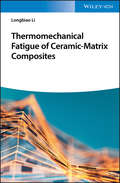- Table View
- List View
Thermodynamics of Crystalline States
by Minoru FujimotoThermodynamics is an established discipline of physics for properties of matter in thermal equilibrium surroundings. Applying to crystals, however, the laws encounter undefined properties of crystal lattices, which therefore need to be determined for a legitimate description of crystalline states. Intended for readers with prior knowledge of condensed matter physics, this book emphasizes the roles played by order variables and dynamic lattices in crystals for thermodynamics of crystalline states. The crystalline state is generally heterogeneous, where order variables are in collective motion interacting with the lattice at excited levels, as witnessed in transition anomalies in dielectric crystals and from superconducting transitions in metals. The collective motion exhibits finite amplitude due to long-range order, breaking lattice symmetry that leads to a structural change. Such a non-linear process is discussed in the chapter of soliton theory, and related experimental evidences are also listed in this book. This book is divided into three parts for the convenience of readers. In Part I, basic concepts of phonons and order variables are reviewed. Part 2 is devoted to discussions of binary transitions, and in Part 3 we discuss superconducting transitions in simple metals.
Thermodynamics of Crystalline States, 2nd Edition
by Minoru FujimotoThermodynamics is a well-established discipline of physics for properties of matter in thermal equilibrium with the surroundings. Applying to crystals, however, the laws encounter undefined properties of crystal lattice, which therefore need to be determined for a clear and well-defined description of crystalline states. Thermodynamics of Crystalline States explores the roles played by order variables and dynamic lattices in crystals in a wholly new way. The book begins by clarifying basic concepts for stable crystals. Next, binary phase transitions are discussed to study collective motion of order variables, as described mostly as classical phenomena. New to this edition is the examination of magnetic crystals, where magnetic symmetry is essential for magnetic phase transitions. The multi-electron system is also discussed theoretically, as a quantum-mechanical example, for superconductivity in metallic crystals. Throughout the book, the role played by the lattice is emphasized and studied in-depth. Thermodynamics of Crystalline States is an introductory treatise and textbook on mesoscopic phenomena in solid states, constituting a basic subject in condensed matter physics. While this book serves as a guide for advanced students in physics and material science, it can also be useful as a reference for all professionals in related fields. Minoru Fujimoto is author of Physics of Classical Electromagnetism (Springer, 2007) and The Physics of Structural Phase Transitions (Springer, 2005).
Thermodynamics of Fluids Under Flow
by José Casas-Vázquez David Jou Manuel Criado-SanchoThis is the second edition of the book "Thermodynamics of Fluids under Flow," which was published in 2000 and has now been corrected, expanded and updated. This is a companion book to our other title Extended irreversible thermodynamics (D. Jou, J. Casas-Vázquez and G. Lebon, Springer, 4th edition 2010), and of the textbook Understanding non-equilibrium thermodynamics (G. Lebon, D. Jou and J. Casas-Vázquez, Springer, 2008. The present book is more specialized than its counterpart, as it focuses its attention on the non-equilibrium thermodynamics of flowing fluids, incorporating non-trivial thermodynamic contributions of the flow, going beyond local equilibrium theories, i.e., including the effects of internal variables and of external forcing due to the flow. Whereas the book's first edition was much more focused on polymer solutions, with brief glimpses into ideal and real gases, the present edition covers a much wider variety of systems, such as: diluted and concentrated polymer solutions, polymer blends, laminar and turbulent superfluids, phonon hydrodynamics and heat transport in nanosystems, nuclear collisions, far-from-equilibrium ideal gases, and molecular solutions. It also deals with a variety of situations, emphasizing the non-equilibrium flow contribution: temperature and entropy in flowing ideal gases, shear-induced effects on phase transitions in real gases and on polymer solutions, stress-induced migration and its application to flow chromatography, Taylor dispersion, anomalous diffusion in flowing systems, the influence of the flow on chemical reactions, and polymer degradation. The new edition is not only broader in scope, but more educational in character, and with more emphasis on applications, in keeping with our times. It provides many examples of how a deeper theoretical understanding may bring new and more efficient applications, forging links between theoretical progress and practical aims. This updated version expands on the trusted content of its predecessor, making it more interesting and useful for a larger audience.
The Thermodynamics of Linear Fluids and Fluid Mixtures
by Miloslav Pekař Ivan SamohýlIn this book, Samohýl and Pekař offer a consistent and general non-equilibrium thermodynamic description for a model of chemically reacting mixtures. This type of model is frequently encountered in practice and up until now, chemically reacting systems (out of equilibrium) have rarely been described in books on non-equilibrium thermodynamics. Readers of this book benefit from the systematic development of the theory; this starts with general principles, going through the applications to single component fluid systems, and finishing with the theory of mixtures, including chemical reactions. The authors describe the simplest mixture model – the linear fluid – and highlight many practical and thermodynamically consistent equations for describing transport properties and reaction kinetics for this model. Further on in the book, the authors also describe more complex models. Samohýl and Pekař take special care to clearly explain all methodology and starting axioms and they also describe in detail applied assumptions and simplifications. This book is suitable for graduate students in chemistry, materials science and chemical engineering as well as professionals working in these and related areas.
Thermodynamics of Polymer Blends, Volume I
by Anatoly E. Nesterov Yuri S. LipatovThermodynamics is an indispensable tool for developing a large and growing fraction of new polymers and polymer blends. These two volumes show the researcher how thermodynamics can be used to rank polymer pairs in order of immiscibility, including the search for suitable chemical structure of compatibilizers. Because of the great current commercial interest in this most dynamic sector of the polymer industry, there is high interest in studying their physical and mechanical properties, their structures, and the processes of their formation and manufacture. These Books are dedicated to Analysis of the Thermodynamics of Polymer Blends. Thermodynamic behavior of blends determines the compatibility of the components, their morphological features, rheological behavior, and microphase structures. As a result, the most important physical and mechanical characteristics of blends can be identified. The information in these two volumes will be useful to all those involved in polymer research, development, analysis and advanced process engineering.
Thermodynamics of Soil Nutrient Bioavailability: Sustainable Soil Nutrient Management
by Kodoth Prabhakaran NairThis book focusses on the thermodynamics of soil nutrient bioavailability, and in particular the most important plant nutrients such as, phosphorus and potassium, among major nutrients, and zinc among micronutrients. It proposes a paradigm shift in the approach to global soil testing procedures. Historically, soil testing has been used to quantify availability of essential plant nutrients to field-grown crops. However, contemporary soil tests are based on philosophies and procedures developed several decades ago, without significant changes in their general approach. For a soil test to be accurate, one needs to clearly understand the physico-chemico-physiological processes at the soil-root interface and, an understanding of soils and plant root systems as polycationic systems is essential. It is this knowledge that leads to sound prescriptive soil nutrient management inasmuch as soil nutrient bioavailability vis-à-vis fertilizer application is concerned, because, of all the factors which govern sustainability in crop production, the nutrient factor is the most important, yet, it is also least resilient to management. This book provides a clear scientific basis of the thermodynamics of soil nutrient bio availability, which routine soil testing does not provide
Thermodynamics of the Glassy State
by Luca Leuzzi Th. M NieuwenhuizenIn the past thirty years, the area of spin glasses has experienced rapid growth, including the development of solvable models for glassy systems. Yet these developments have only been recorded in the original research papers, rather than in a single source. Thermodynamics of the Glassy State presents a comprehensive account of the modern theory of
Thermodynamics with Chemical Engineering Applications
by Elias I. FransesMaster the principles of thermodynamics with this comprehensive undergraduate textbook, carefully developed to provide students of chemical engineering and chemistry with a deep and intuitive understanding of the practical applications of these fundamental ideas and principles. Logical and lucid explanations introduce core thermodynamic concepts in the context of their measurement and experimental origin, giving students a thorough understanding of how theoretical concepts apply to practical situations. A broad range of real-world applications relate key topics to contemporary issues, such as energy efficiency, environmental engineering and climate change, and further reinforce students' understanding of the core material. This is a carefully organized, highly pedagogical treatment, including over 500 open-ended study questions for discussion, over 150 varied homework problems, clear and objective standards for measuring student progress, and a password-protected solution manual for instructors.
Thermodynamik: Physikalisch-chemische Grundlagen für Naturwissenschaftler und Ingenieure der thermischen Verfahrenstechnik
by Christa Lüdecke Dorothea LüdeckePhysikalisch-chemische Grundlagen für Naturwissenschaftler und Ingenieure der thermischen Verfahrenstechnik · Grundlagen der Thermodynamik verständlich erklärt · Impulse zur praktischen Anwendung in der Verfahrenstechnik · Praktische Lernhilfe durch viele ausführliche Bespiele · Formelsammlung und Datensammlung zum Nachschlagen Dieses Buch führt Sie in das physikalisch-chemische Gebiet der Thermodynamik ein Dieses Buch vermittelt Ihnen die physikalisch-chemischen Grundlagen der Thermodynamik. Im Fokus der Autorinnen steht dabei die Thermodynamik der Phasengleichgewichte als Grundlage thermischer Trennverfahren. Die Thermodynamik wird häufig als ein schwer zugängliches und abstraktes Teilgebiet der Physik wahrgenommen. Dieses Buch schafft Abhilfe, indem es die Grundlagen der Thermodynamik verständlich erklärt und eine Verbindung zu den praktischen Anwendungen der thermischen Verfahrenstechnik herstellt. Aufbauend auf den theoretischen Grundlagen beschreiben die Autorinnen die thermodynamischen Eigenschaften von reinen Fluiden und Mischungen mit Hilfe von Zustandsgleichungen und Phasendiagrammen. Die Berechnung von Phasengleichgewichten sowie die Trennung von Mischungen in ihre reinen Komponenten werden ausführlich erläutert. Auf dieses Weise stellen die Autorinnen dieses Thermodynamik-Buchs selbst komplizierte und komplexe Sachverhalte leicht nachvollziehbar dar. Zusätzlich erleichtern Ihnen zahlreiche anwendungsorientierte Beispiele sowie anschauliche Diagramme das Verständnis. Grundlagen und Praktische Lösungen in einem Christa und Dorothea Lüdecke erläutern in diesem Buch über die Thermodynamik zunächst wichtige Grundbegriffe wie die Hauptsätze und die thermodynamischen Potentiale. Mit diesem Basiswissen gelingt es Ihnen in Ihrem Studium, sich leicht auch die Spezialgebiete der folgenden Kapitel zu erarbeiten: • Thermodynamische Eigenschaften reiner Fluide • Thermodynamische Eigenschaften homogener Mischungen • Phasengleichgewichte mehrkomponentiger Systeme Die wichtigsten Gleichungen werden selbstverständlich nach ihrer Herleitung in detaillierten Beispielen angewendet, die Ihnen helfen, eigenständig Lösungen für praktische Probleme der Verfahrenstechnik zu finden. Ein Nachschlagewerk für Studium und Beruf Die wichtigsten Aussagen aller Kapitel sind im Anhang am Ende dieses Werks noch einmal übersichtlich zusammengestellt. Diese ausführliche Zusammenfassung stellt ein Repetitorium und eine eigenständige Formelsammlung zum schnellen Nachschlagen dar. Zusätzlich finden Sie im Anhang viele Tabellen mit thermodynamischen Daten – eine nützliche Sammlung für Ihre Berechnungen – sowie ein deutsch-englisches Verzeichnis der verwendeten Begriffe. All dies macht dieses Thermodynamik-Buch zu einem treuen Begleiter in Grund- und Hauptstudium bis hinein in die berufliche Praxis. Zu einer besonderen Empfehlung wird es daher für: · Studierende der Naturwissenschaft und Verfahrenstechnik
Thermodynamik: Einstoffsysteme
by Karlheinz Schaber Franz Mayinger Peter Stephan Karl StephanIn Band 1 des zweiteiligen Grundlagenwerks zur Thermodynamik wird die Theorie systematisch entwickelt. Bilanzen und allgemein gültige Zusammenhänge zwischen thermodynamischen Zustandsgrößen werden zunächst für beliebige thermodynamische Systeme abgeleitet und danach auf eine Vielzahl von Spezialfällen angewandt. Der Band enthält Berechnungsbeispiele mit ausführlichen Lösungen sowie Übungsaufgaben. Für die 18. Auflage wurde das Kapitel über Stoffeigenschaften aktualisiert und die Abschnitte zu den wichtigsten thermodynamischen Prozessen erweitert.
Thermoelectric Bi2Te3 Nanomaterials
by Friedemann Völklein Nicola Peranio Kornelius Nielsch Oliver EiblEdited by the initiators of a priority research program funded by the German Science Foundation and written by an international team of key players, this is the first book to provide an overview of nanostructured thermoelectric materials -- putting the new developments into perspective alongside conventional thermoelectrics. As such, it reviews the current state of research on thermoelectric Bi2Te3 nanomaterials, covering advanced methods of materials synthesis, characterization of materials structures and thermoelectric properties, as well as advances in the theory and modeling of transport properties. Nanomaterials-based thermoelectric devices are also discussed with respect to their properties, their suitability for different energy generation applications, and in light of their commercialization potential. An outlook on the chances, challenges and future directions of research rounds off the book, giving a straightforward account of the fundamental and technical problems - plus ways to overcome them.
Thermoelectric Energy Conversion: Basic Concepts and Device Applications
by Diana Davila Pineda Alireza Rezaniakolaei Oliver Brand Gary K. Fedder Christofer Hierold Jan G. Korvink Osamu TabataThe latest volume in the well-established AMN series, this ready reference provides an up-to-date, self-contained summary of recent developments in the technologies and systems for thermoelectricity. Following an initial chapter that introduces the fundamentals and principles of thermoelectricity, subsequent chapters discuss the synthesis and integration of various bulk thermoelectric as well as nanostructured materials. The book then goes on to discuss characterization techniques, including various light and mechanic microscopy techniques, while also summarizing applications for thermoelectric materials, such as micro- and nano-thermoelectric generators, wearable electronics and energy conversion devices. The result is a bridge between industry and scientific researchers seeking to develop thermoelectric generators.
Thermoelectric Nanomaterials: Materials Design and Applications
by Kunihito Koumoto Takao MoriPresently, there is an intense race throughout the world to develop good enough thermoelectric materials which can be used in wide scale applications. This book focuses comprehensively on very recent up-to-date breakthroughs in thermoelectrics utilizing nanomaterials and methods based in nanoscience. Importantly, it provides the readers with methodology and concepts utilizing atomic scale and nanoscale materials design (such as superlattice structuring, atomic network structuring and properties control, electron correlation design, low dimensionality, nanostructuring, etc.). Furthermore, also indicates the applications of thermoelectrics expected for the large emerging energy market. This book has a wide appeal and application value for anyone being interested in state-of-the-art thermoelectrics and/or actual viable applications in nanotechnology.
Thermoelectric Skutterudites
by Ctirad UherThis book informs the reader about a fascinating class of materials referred to as skutterudites, the atomic lattice of which has large structural voids that can be filled by a variety of foreign species, spanning from alkali to alkaline to rare earth ions. The fillers, in their unique way, drastically modify the physical properties of the parent structure, giving rise to outstanding thermoelectric properties. This exciting material is of growing importance and is finding applications in a variety of different fields. This book will be of interest to researchers working in materials science, physics, and chemistry in addition to graduate students in these subjects. Features:• Gives a comprehensive account of all fundamental physical properties of skutterudites• Each major topic is accompanied by introductory sections and a further detailed theoretical treatment is provided in Appendices• Supported by many figures and a vast number of relevant references
Thermoelectric Thin Films: Materials and Devices
by Paolo Mele Dario Narducci Michihiro Ohta Kanishka Biswas Juan Morante Shrikant Saini Tamio EndoThis book will provide readers with deep insight into the intriguing science of thermoelectric thin films. It serves as a fundamental information source on the techniques and methodologies involved in thermoelectric thin film growth, characterization and device processing. This book involves widespread contributions on several categories of thermoelectric thin films: oxides, chalcogenides, iodates, nitrides and polymers. This will serve as an invaluable resource for experts to consolidate their knowledge and will provide insight and inspiration to beginners wishing to learn about thermoelectric thin films.Provides a single-source reference on a wide spectrum of topics related to thermoelectric thin films, from organic chemistry to devices, from physical chemistry to applied physics, from synthesis to device implementation;Covers several categories of thermoelectric thin films based on different material approaches such as oxides, chalcogenides, iodates, nitrides and polymers;Discusses synthesis, characterization, and device processing of thermoelectric thin films, as well as the nanoengineering approach to tailor the properties of the used materials at the nanoscale level.
Thermoelectrical Effect in SiC for High-Temperature MEMS Sensors (SpringerBriefs in Applied Sciences and Technology)
by Toan Dinh Nam-Trung Nguyen Dzung Viet DaoThis book presents the fundamentals of the thermoelectrical effect in silicon carbide (SiC), including the thermoresistive, thermoelectric, thermocapacitive and thermoelectronic effects. It summarizes the growth of SiC, its properties and fabrication processes for SiC devices and introduces the thermoelectrical sensing theories in different SiC morphologies and polytypes. Further, it reviews the recent advances in the characterization of the thermoelectrical effect in SiC at high temperatures. Discussing several desirable features of thermoelectrical SiC sensors and recent developments in these sensors, the book provides useful guidance on developing high sensitivity and linearity, fast-response SiC sensing devices based on thermoelectrical effects.
Thermoelectrics: Design and Materials
by Hosung LeeThermoelectrics: Design and Materials HoSung Lee, Western Michigan University, USA A comprehensive guide to the basic principles of thermoelectrics Thermoelectrics plays an important role in energy conversion and electronic temperature control. The book comprehensively covers the basic physical principles of thermoelectrics as well as recent developments and design strategies of materials and devices. The book is divided into two sections: the first section is concerned with design and begins with an introduction to the fast developing and multidisciplinary field of thermoelectrics. This section also covers thermoelectric generators and coolers (refrigerators) before examining optimal design with dimensional analysis. A number of applications are considered, including solar thermoelectric generators, thermoelectric air conditioners and refrigerators, thermoelectric coolers for electronic devices, thermoelectric compact heat exchangers, and biomedical thermoelectric energy harvesting systems. The second section focuses on materials, and covers the physics of electrons and phonons, theoretical modeling of thermoelectric transport properties, thermoelectric materials, and nanostructures. Key features: Provides an introduction to a fast developing and interdisciplinary field. Includes detailed, fundamental theories. Offers a platform for advanced study. Thermoelectrics: Design and Materials is a comprehensive reference ideal for engineering students, as well as researchers and practitioners working in thermodynamics. Cover designed by Yujin Lee
Thermoelectrics: Design and Materials
by HoSung LeeComplete introduction to the field of thermoelectrics, covering materials, applications, recent developments, and more, with end-of-chapter problems included throughout Thermoelectrics provides an introduction to the fundamental theories in the fast developing and interdisciplinary field of thermoelectrics. The topics covered are in sync with contemporary technology advancement happenings within the TEC/TEG electronics cooling community and include discussion of challenges and concerns surrounding practical applications. The first section covers thermoelectric generators and coolers (refrigerators) before examining optimal design with dimensional analysis. A number of applications are considered, including solar thermoelectric generators, thermoelectric air conditioners and refrigerators, thermoelectric coolers for electronic devices, thermoelectric compact heat exchangers, and biomedical thermoelectric energy harvesting systems. The second section focuses on materials and covers the physics of electrons and phonons, theoretical modeling of thermoelectric transport properties, thermoelectric materials, and nanostructures. In this Second Edition, many new examples and end-of-chapter problems have been added. New results from the theories have been added in certain chapters, along with new design charts and many examples showing how to use the charts. A companion website hosts solution manuals and appendices. Sample topics covered in Thermoelectrics include: Thermoelectric effects, including the Seebeck, Peltier, and Thomson effects as well as Thomson/Kelvin relationshipsPerformance, maximum, abnormal parameters for thermoelectric modules as well as effective material propertiesThermal and electrical contact resistances for micro and macro devices, with information on modeling and validationThermoelectric transport properties, covering Seebeck coefficient, electrical conductivity, lattice and electronic thermal conductivitiesLow-dimensional nanostructures, covering quantum wells, wires, and dots and supporting proof-of-principle studies Thermoelectrics is an ideal resource on the fundamentals of the subject for professionals in the electronics cooling industry, solid state physicists, and materials scientists and engineers. It is also a valuable reference for early career scientists and undergraduate and graduate students in related programs of study.
Thermoelectrics: Fundamentals, Materials Selection, Properties, and Performance (SpringerBriefs in Materials)
by N. M. Ravindra Bhakti Jariwala Asahel Bañobre Aniket MaskeThis book provides a concise but comprehensive introduction to the fundamentals and current state of the art in thermoelectrics. Addressing an audience of materials scientists and engineers, the book covers theory, materials selection, and applications, with a wide variety of case studies reflecting the most up-to-date research approaches from the past decade, from single crystal to polycrystalline form and from bulk to thin films to nano dimensions. The world is facing major challenges for finding alternate energy sources that can satisfy the increasing demand for energy consumption while preserving the environment. The field of thermoelectrics has long been recognized as a potential and ideal source of clean energy. However, the relatively low conversion efficiency of thermoelectric devices has prevented their utility on a large scale. While addressing the need for thermal management in materials, device components, and systems, thermoelectrics provides a fundamental solution to waste heat recovery and temperature control. This book summarizes the global efforts that have been made to enhance the figure of merit of various thermoelectric materials by choosing appropriate processes and their influence on properties and performance. Because of these advances, today, thermoelectric devices are found in mainstream applications such as automobiles and power generators, as opposed to just a few years ago when they could only be used in niche applications such as in aeronautics, infrared imaging, and space. However, the continued gap between fundamental theoretical results and actual experimental data of figure of merit and performance continues to challenge the commercial applications of thermoelectrics. This book presents both recent achievements and continuing challenges, and represents essential reading for researchers working in this area in universities, industry, and national labs.
Thermoelectrics Handbook: Macro to Nano
by D. M. RoweTen years ago, D.M. Rowe introduced the bestselling CRC Handbook of Thermoelectrics to wide acclaim. Since then, increasing environmental concerns, desire for long-life electrical power sources, and continued progress in miniaturization of electronics has led to a substantial increase in research activity involving thermoelectrics. Reflecting the latest trends and developments, the Thermoelectrics Handbook: Macro to Nano is an extension of the earlier work and covers the entire range of thermoelectrics disciplines.Serving as a convenient reference as well as a thorough introduction to thermoelectrics, this book includes contributions from 99 leading authorities from around the world. Its coverage spans from general principles and theoretical concepts to material preparation and measurements; thermoelectric materials; thermoelements, modules, and devices; and thermoelectric systems and applications. Reflecting the enormous impact of nanotechnology on the field-as the thermoelectric properties of nanostructured materials far surpass the performance of conventional materials-each section progresses systematically from macro-scale to micro/nano-scale topics. In addition, the book contains an appendix listing major manufacturers and suppliers of thermoelectric modules.There is no longer any need to spend hours plodding through the journal literature for information. The Thermoelectrics Handbook: Macro to Nano offers a timely, comprehensive treatment of all areas of thermoelectrics in a single, unified reference.
Thermofluid Dynamics: Unusual Problems with Analytical Solutions (UNIPA Springer Series)
by Michele CiofaloThis book gathers ten thermofluid dynamics problems involving the use of analytical solutions. All these problems have been encountered by the author during his research activity; some of the solutions are his own contributions, while others either are classic literature results or can be derived from them. The physical phenomena involved range from pure hydrodynamics to flow with heat or mass transfer, two-phase flow, and magnetohydrodynamics. The problems discussed are not canonical problems; they are rarely found in textbooks, and often exhibit surprising, or even paradoxical, solutions. The potential readership of the book includes students, teachers and scientists in science and engineering interested in fluid dynamics and heat/mass transfer: to them it may offer food for thought, suggestions for lectures or tutorials and ideas for further original developments.
Thermofluid Dynamics of Turbulent Flows: Fundamentals and Modelling (UNIPA Springer Series)
by Michele CiofaloThe book provides the theoretical fundamentals on turbulence and a complete overview of turbulence models, from the simplest to the most advanced ones including Direct and Large Eddy Simulation. It mainly focuses on problems of modeling and computation, and provides information regarding the theory of dynamical systems and their bifurcations. It also examines turbulence aspects which are not treated in most existing books on this subject, such as turbulence in free and mixed convection, transient turbulence and transition to turbulence. The book adopts the tensor notation, which is the most appropriate to deal with intrinsically tensor quantities such as stresses and strain rates, and for those who are not familiar with it an Appendix on tensor algebra and tensor notation are provided.
Thermoforming: A Plastics Processing Guide, Second Edition
by Geza GruenwaldFROM THE FOREWORDDr. Gruenwald has indicated the desirable properties of polymerics for differing applications; thus, his text is especially useful for polymer chemists who must ""tailor"" plastic materials for specific groups of applications. Engineers in extruding and calendering film and sheet will benefit from the intimate relationships elucidated between processing parameters imposed upon stocks employed in thermoforming and the products thereof. Mold designers are provided with a complete guide that will enable them to avoid the less obvious pitfalls and wasted effort so often experienced in the evolution of molds for (especially) complex parts.. Quite likely, Dr. Gruenwald's suggestions willl lead to considerable benefits to those who read and practice by this remarkable exposition of thermoforming technology. Robert K. Jordan Director-Metalliding Institute, Director-Engineering Research Institute, Scientist in Residence, Gannon University
Thermoforming: Processing and Technology
by Muralisrinivasan Natamai SubramanianThis book is a comprehensive reference manual that contains essential information on thermoforming processing and technology. The field of thermoforming is experiencing rapid development driven by commercial factors; millions of tons of polymers are manufactured for use in various applications, both as commodity and specialty polymers. Building on the previous edition published about ten years ago, this edition includes new, as well as, fully revised chapters and updated information on materials and processes. The book is designed to provide practitioners with essential information on processing and technology in a concise manner. The book caters to both engineers and experts by providing introductory aspects, background information, and an overview of thermoforming processing and technology. The troubleshooting section includes flowcharts to assist in correcting thermoforming processes. >em>Thermoforming: Processing and Technology offers a complete account of thermoplastics, covering properties and forming, with chapters providing perspective on the technologies involved. Readers will find it: serves as a handy knowledge source for professionals who occasionally work on thermoforming projects or need to refresh their knowledge; offers a troubleshooting guide that can help to identify and solve challenges that may arise in thermoforming processes; provides insights into process optimization, helping businesses improve efficiency, reduce waste, and enhance the quality of thermoformed products; acts as a course book to inform students about the thermoforming process. Audience The book will be of interest to mechanical, materials engineers, and process engineers who are involved in designing and optimizing thermoforming processes; professionals in the manufacturing and production industries who use thermoforming as a manufacturing method, such as in the production of plastic packaging, automotive components, and consumer goods; scientists, researchers, and students in plastics/polymer engineering and technology, materials science, polymer technology; professionals responsible for ensuring product quality and compliance with industry standards.
Thermomechanical Fatigue of Ceramic-Matrix Composites
by Longbiao LiGuides researchers and practitioners toward developing highly reliable ceramic-matrix composites The book systematically introduces the thermomechanical fatigue behavior of fiber-reinforced ceramic-matrix composites (CMCs) and environmental barrier coatings, including cyclic loading/unloading tensile behavior, cyclic fatigue behavior, dwell-fatigue behavior, thermomechanical fatigue behavior, and interface degradation behavior. It discusses experimental verification of CMCs and explains how to determine the thermomechanical properties. It also presents damage evolution models, lifetime prediction methods, and interface degradation rules. Thermomechanical Fatigue of Ceramic-Matrix Composites offers chapters covering unidirectional ceramic-matrix composites and cross-ply and 2D woven ceramic-matrix composites. For cyclic fatigue behavior of CMCs, it looks at the effects of fiber volume fraction, fatigue peak stress, fatigue stress ratio, matrix crack spacing, matrix crack mode, and woven structure on fatigue damage evolution. Both the Dwell-fatigue damage evolution and lifetime predictions models are introduced in the next chapter. Experimental comparisons of the cross-ply SiC/MAS composite, 2D SiC/SiC composite, and 2D NextelTM 720/Alumina composite are also included. Remaining sections examine: thermomechanical fatigue hysteresis loops; in-phase thermomechanical fatigue damage; out-of-phase thermomechanical fatigue; interface degradation models; and much more. -Offers unique content dedicated to thermomechanical fatigue behavior of ceramic-matrix composites (CMCs) and environmental barrier coatings -Features comprehensive data tables and experimental verifications -Covers a highly application-oriented subject?CMCs are being increasingly utilized in jet engines, industrial turbines, and exhaust systems Thermomechanical Fatigue of Ceramic-Matrix Composites is an excellent book for developers and users of CMCs, as well as organizations involved in evaluation and characterization of CMCs. It will appeal to materials scientists, construction engineers, process engineers, and mechanical engineers.
